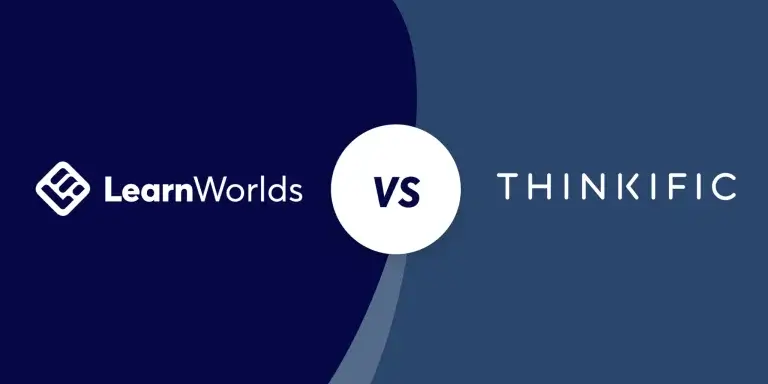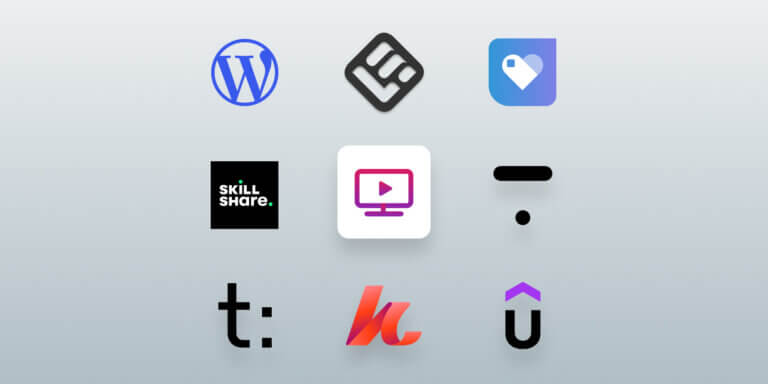Table of Contents
According to the Future of Jobs report 2025 [1], developing technology skills is increasing in importance in the financial sector.
The rising consumer expectations and unprecedented integration of technology are only a couple of the reasons why financial institutions need help modernizing their services and keeping their clients.
When approached methodically and with a forward-looking mindset, employee upskilling can make a huge difference and help the finance sector pick up the pace and stay at the forefront of technological innovations, and guarantee superior customer service.
This post will leave no stone unturned – we’ll dive deep into the challenges the financial sector is facing and see how upskilling the workforce can successfully address them. We’ll also share a step-by-step guide for building effective employee upskilling programs.
What is an employee upskilling program?
An employee upskilling program is a training initiative offered by an employer to help their employees acquire new skills or improve existing ones.
Such programs aim to enhance employee performance, support career goals, strengthen the company’s competitive edge, and improve employee satisfaction and retention.
Upskilling programs can take various forms, like on-site training, online courses (custom or off-the-shelf), mentorship programs, job shadowing, and workshops.
The topics covered can be job or industry-specific, like “cybersecurity compliance in the finance sector”. But with leaders across all sectors realizing the importance of soft skills, training topics such as analytical skills, communication, or project management training also focus on broader topics.
Why is an upskill program important for employee training?
An upskill program is important for employee training because it lets organizations build on the skills their workforce already has to keep them productive, adaptable, and on top of their game.
As the tech landscape keeps evolving and job roles get turned on their head, employees need to either get new skills under their belt or brush up on the ones they already have to meet the changing demands. A systematized upskilling plan ensures that your employees stay confident in their abilities, get the job done efficiently, and ultimately help the business keep growing.
💡Keep learning: The critical role of employee training and development
Why upskilling is a competitive advantage in financial services
In finance, upskilling is what gives companies a head start on their competition because it lets them keep pace with the rapid-fire changes brought on by digital transformation and regulatory overhaul. As fintech innovations, AI, and automation start to take hold, the companies with a skilled and adaptable workforce are the ones that can integrate new tech the fastest, offer customers a more personalized experience, and make sure they’re in line with changing legal standards.
Upskilling also drives innovation and helps you bounce back from setbacks. When your employees are trained in emerging fields like cybersecurity, data analysis, and AI-powered financial tools, they’re equipped to sniff out opportunities, mitigate risks, and deliver smarter services more efficiently. At the end of the day, a well-trained workforce is your company’s most valuable asset – it helps financial organizations build trust, stay nimble, and stay profitable in a super competitive market.
💡Keep learning: How to use AI training to keep your business ahead of the competition
Benefits of upskilling employees
Employee upskilling offers several benefits regardless of the industry an organization operates. Let’s see these benefits before specifically addressing the financial sector.
Improved job performance
When employees receive job-specific or soft skills training, they enhance their competencies and adaptability. Therefore, they become more efficient when performing their daily tasks and better prepared for future developments that may require them to work following new processes or using new tools.
Increased innovation
Upskilling provides employees with the necessary knowledge and skills to stay updated with the latest industry trends. Most importantly, it keeps their minds sharp and ignites creativity, which eventually helps them come up with innovative solutions that can bring the company above the competition.
Customer loyalty
When employees are well-trained and have the necessary skills to perform their jobs efficiently and without mistakes, this reflects both on how they serve clients (if they have a client-facing position) and the end product/service a company offers. Upskilling training can significantly improve customer satisfaction and loyalty.
Higher employee engagement and retention
Providing employees with opportunities to learn new skills and grow leads to increased job satisfaction and a sense of fulfillment in their career path.
As they become more competent and teamwork improves, employees are happier with their job and their workplace – not to mention that they have increased chances of getting promoted. This, in turn, leads to greater employee retention.
Enhanced reputation
A competent workforce can help an organization stay competitive by offering quality products & services, keeping up with – or even leading – industry trends, and swiftly adapting to increasing customer needs. This is how upskilling in the workplace leads to increased brand recognition and positive word-of-mouth.
Increased revenue
As a result of all the above – improved job performance, lower employee turnover, innovation, customer loyalty, and competitiveness – companies that invest in employee upskilling enjoy higher revenue and financial stability.
Upskilling vs. reskilling: Key differences
Upskilling and Reskilling – two complementary parts of any solid employee development plan – but they serve distinct objectives. Upskilling is all about helping your staff build on what they already know and do, in order to do their current job a lot better or take on more advanced responsibilities. Reskilling, on the other hand, is about giving employees a whole new set of skills to tackle a different role inside the company, often as a reaction to new tech or changes in the org structure.
While both strategies help out a lot with workforce adaptability and keeping the business running smoothly, upskilling is more about continually making your current roles better and more innovative, whereas reskilling is about helping people move into new careers and helping your business fill the gaps that can come when automation, for example, kicks in.
Examples of upskilling skills
The type of skills that are in high demand varies by industry, but the core skills needed are usually a mix of technical, analytical, and social ones that allow people to succeed in the modern workplace – and that are in high demand in today’s labor market. Having said that, both hard and soft skills are key to staying competitive and keeping up with the pace of change.
Some common examples of upskilling skills include digital literacy, data analysis, leadership, project management, and communication. To improve learning, you can boost skill training with ChatGPT to create real-world scenarios and provide feedback more effectively so that your employees learn how they can keep on improving.
Top skills to focus on in financial sector upskilling programs
Since we are talking about the financial sector, the upskilling initiative needs to be in tune with what’s happening in the sector. This is all about the impact of new tech on data security and customer experience.
Financial sector employers are going to be under increasing pressure to stay compliant, keep customer data safe, and be digitally competent, too. They need to balance the need to innovate with the need to keep a human element in what they do.
So upskilling programs in finance should focus on developing skills that are both tech-related and people skills. Through these, employees will be able to use innovation in a way that is real and practical and gets results.
Some key skills to focus on include:
Upskilling statistics for 2025
The global workforce is in the middle of a massive transformation, and suddenly, getting your workforce upskilled is a must-have strategy – not a nice-to-have – across all industries.
A look at the latest research and the Future of Jobs Report 2025, and you can see why: organizations that actually invest in skill development are enjoying better retention rates, faster innovation, and a real boost to their bottom line.
In the financial services sector, it’s all about keeping up with the times. Digital transformation and automation are driving a huge demand for AI, compliance, and cybersecurity skills, so upskilling is no longer just a nice idea; it’s a necessity for 2025 and beyond.
Here are some interesting statistics to keep in mind:
Key challenges in the financial services sector & how employee upskilling can address them
We briefly mentioned that technology and consumer demands are shaping the financial sector – but there’s more to it. In this section, we’re going into detail about the challenges the financial sector is facing and how employee upskilling can address each one.
Integration of technology
The financial services sector has leveraged technology to the maximum to improve customer experience and streamline operations.
The integration of technology has revolutionized the industry, with new fintech companies emerging and traditional financial institutions embracing digital transformation.
Some aspects where the integration of technology is prominent are:
💡 How employee upskilling can help
The integration of technology in the financial services sector has created challenges, such as the need to ensure cybersecurity, protect customer privacy & sensitive data, and address regulatory requirements.
Financial institutions need to invest in upskilling the workforce to ensure that their employees are equipped with the skills and knowledge to effectively leverage technology while addressing these challenges:
Compliance & regulation
Financial institutions need to comply with ever-changing regulations to protect their customer’s data and assets, such as Anti-money laundering (AML) regulations, GDPR, Know Your Customer (KYC), and Payment Services Directive (PSD2).
Failure to comply with these regulations can cause legal and financial implications and damage their reputation.
💡 How employee upskilling can help
Compliance training is critical for financial services businesses because the financial sector simply can’t afford not to follow strict regulations when so much data and assets are at stake. Employee upskilling helps with:
Cybersecurity concerns
The financial sector was the sector that suffered the most DDoS (Denial of Service) attacks in 2022. A successful cyber attack can have massive repercussions for a financial institution, forever compromising its reputation and resulting in significant legal implications and monetary losses.
Here are some common cybersecurity threats in the financial sector:
💡 How employee upskilling can help
Recent research from the IMF found that the skills gap and preparedness against cyber attacks are enormous. 64% of participants do not mandate testing and exercising cybersecurity, while 54% lack a dedicated cyber incident reporting regime.
This means that companies are still not taking cybersecurity risks as seriously as they should. However, well-designed employee upskilling courses could save them from big trouble by:
Increasing customer demands
Customers are more knowledgeable and demanding than ever. This is largely due to the high expectations that technology has created, but not only. The changing societal landscape and the financial crisis have sensitized customers.
Aspects of this transformation include:
💡 How employee upskilling can help
Customer experience and, consequently, customer satisfaction are top priorities for any business. Upskilling can help employees meet the demands of their clients and maintain their loyalty by developing:
Negative perceptions
Customers are negatively predisposed and view financial institutions with skepticism. Let’s see some common perceptions that circulate:
💡 How employee upskilling can help
These negative perceptions can impact a financial institution’s reputation and customer loyalty. Financial institutions must address these perceptions by improving customer service, simplifying their products and services, and ensuring fair treatment of all customers. Upskilling in the workplace can provide training for:
Essential ingredients for a powerful financial sector employee upskilling program
Let’s see now how you can level up your workforce with effective upskilling programs.

Identify skills gaps and training needs
Spend some time and resources identifying skills gaps in your organization, so you can develop training that addresses your actual training needs. Otherwise, productivity and compliance issues will remain – and you’ll have wasted your training budget in vain.
You can discover areas and skill sets your employees need support with by conducting interviews with managers and employees, skills assessments, and surveys.
Follow a blended learning approach
After identifying skills gaps, you should decide how you will deliver the upskilling program. There are several options here:
We suggest following a blended learning approach for better results. Investing in a Learning Management System (LMS) will help you deliver different types of content like eBooks, videos, and podcasts. Employees can go over this material at their own pace and time – something that is not an option with on-site training.
Besides, don’t forget that your LMS can serve as an excellent knowledge base that employees can refer to while on the job. If your training is also addressed to desk-less employees, you can deliver it via a mobile app, as many LMSs offer this option as well.
Overall, an LMS for upskilling is the best way to deploy streamlined training at a large scale to a dispersed audience, minimizing the cost.
In some cases, you may need to carry out in-person training, especially for job-related tasks, or some synchronous online sessions to go over complex topics.
Develop customized learning paths and content
Not all employees will be at the same knowledge level. That’s one more reason why you need to carry out a skills assessment – and also a reason to deliver training that can be custom-tailored to each employee’s needs.
One way to go about this is to buy off-the-shelf content. Ready-made courses are a great option for more generic courses, like leadership and D&I, or when you need a compliance training course developed by a certified institution. In this case, you can choose among different difficulty levels and assign the courses accordingly.
When developing customized courses, you can use an LMS and create customized learning paths by setting course prerequisites, including various assessments throughout, and drip-feeding content, i.e., releasing it at specific intervals.
Make sure you offer diverse learning material for your auditory, visual, and kinesthetic learners, like:
And set up some practice sessions for technical skills. This will also help them utilize the content best when they need it.
💁 For example, when they’re on the job and have a customer waiting for an answer, the employee should have access to a quick checklist.
Evaluate the effectiveness of your employee upskilling program
After your employee upskilling program concludes, you must ensure that it has been successful and brought real value to employees. Luckily, you have a few tools in your arsenal:
Tools and platforms to power your upskilling programs
To get the most out of upskilling initiatives, orgs need a few key things – the right tools and platforms that help people learn in a way that feels personal, and that give them the data and flexibility they need to really make the most of it.
Upskilling these days is all about digital learning environments – think of Learning Management Systems (LMS) we mentioned previously, authoring tools, and AI-powered solutions that help the HR and L&D teams make learning experiences that actually drive results.
These platforms make it easy to get all your employee training resources in one place, but they also make it possible for people to keep learning on the go, with mobile access, gamification, and real-time tracking of progress. And that’s exactly what you need to deliver high-quality learning on a large scale, while still giving people the freedom to learn in their own way.
Key tools to power up your employee upskilling program include:
With LearnWorlds, you can get every part of your upskilling program running smoothly – from creating courses to delivering them and getting results – and all the while keep your employees engaged and driving growth.
Successful upskilling program examples in financial services companies
We have collected some examples of top financial institutions offering employee upskilling programs. These institutions have made lifelong learning part of their company culture and proudly display it as a benefit for attracting new candidates.
J.P. Morgan

J.P. Morgan is a world-renowned financial institution. They take pride in their commitment to promoting career growth and mobility, having invested $300 million in employee training and professional development.
Their training programs include development sessions for their employees in technology roles, but they also expand to training in the D&I/leadership sector, offering courses like Advancing Black Leaders.
Bank of America

The Academy of the Bank of America provides continuous learning opportunities for its employees with personalized guidance and the use of the latest technologies, like VR and conversation simulators. More than 40,000 employees receive training every year.
The Bank of America takes it a step further, offering free courses addressed to a wider audience outside its workforce.
Goldman Sachs

Another giant in the financial services sector, Goldman Sachs offers their employees onboarding programs, skills-based education, leadership training & project management, complementing their offering with a library of digital resources.
HSBC

HSBC puts a big emphasis on digital upskilling and training for the future to get its global workforce ready for all the changes that are coming its way. The bank is focusing on building skills in areas like data analysis, cybersecurity, and sustainable finance.
They’ve got flexible online courses and certification programs available to make it easier for staff to learn at their own pace. And by making a real culture of continuous learning, HSBC is helping people grow in their jobs and making the whole organization more agile in the process.
How to maintain a continuous upskilling culture
Building a culture of continuous upskilling ensures that employees can stay ahead of the curve when it comes to new tech, regulations, and what customers are looking for. And it’s not about just doing this once, it’s about making learning an everyday part of the job – something that’s embedded into every day’s workflow.
To keep this culture going, financial institutions need to create a work environment that actually values learning. A workplace where people are encouraged to be curious, innovators, and always looking to grow and learning is actually supported, backed, and even rewarded at every level.
Here’s how to make continuous upskilling a culture that sticks:
Measuring the ROI of employee upskilling in finance
If you want to get investment in training initiatives, then you need to be able to justify the return on investment (ROI) of upskilling programs – and in finance, this involves linking what people learn directly to the key things that influence the bottom line. For example, how productive people are, how happy customers are, how well you are complying with regulations, and how you are managing risk.
It’s not just a matter of counting how many courses people have finished. What you need is to be able to show how learning is really affecting the key business numbers. In finance, you might measure this through metrics like how few compliance problems you have, how quickly projects get delivered, how well you are retaining staff, how innovative your people are, and how much trust customers are putting in you.
Leadership’s role in driving upskilling success
Putting a strong upskilling program in place will only ever be as good as the leader who is championing it. Leaders set the tone. They make sure that learning is connected to the overall strategy of the organization, they make sure that the right resources are in the right place, and they model a growth mindset themselves. When leaders make it clear that they value learning, then people are more likely to be interested in learning.
In the finance sector, where change is happening so fast, leaders are key in guiding their teams through this. How? By making it clear that learning is valued, recognizing progress, creating a culture of lifelong learning where people can experiment and try new things, they empower their teams to tackle the new and the unfamiliar – and that’s when innovation and long-term success can really take off.
Create upskilling courses with LearnWorlds
The financial industry is constantly evolving, and the need for employee upskilling programs has never been more urgent. With new technologies, regulations, consumer demands, and cybersecurity threats emerging all the time, financial institutions must take action to stay ahead of the game.
Deploying an employee upskilling program doesn’t have to be a daunting task. With the help of a powerful LMS for employee training like LearnWorlds, financial businesses can create a streamlined and effective training program in no time.
By using LearnWorlds, you’ll have access to all the tools you need to create, deliver, and track your training content. The platform’s user-friendly interface and robust features make it easy to build customized employee upskilling courses that meet the unique needs of your business.
Ready to take your financial business to the next level? Start your journey towards a more skilled and motivated workforce today with LearnWorlds. And with a 30-day free trial, there’s no reason not to give it a try.
Sources
[1] Future of Jobs Report 2025

Androniki Koumadoraki
Androniki is a Content Writer at LearnWorlds sharing Instructional Design and marketing tips. With solid experience in B2B writing and technical translation, she is passionate about learning and spreading knowledge. She is also an aspiring yogi, a book nerd, and a talented transponster.
Kyriaki is the SEO Content Manager at LearnWorlds, where she writes and edits content about marketing and e-learning, helping course creators build, market, and sell successful online courses. With a degree in Career Guidance and a solid background in education management and career development, she combines strategic insight with a passion for lifelong learning. Outside of work, she enjoys expressing her creativity through music.
FAQ
Everything you have ever wondered, but were too afraid to ask...







